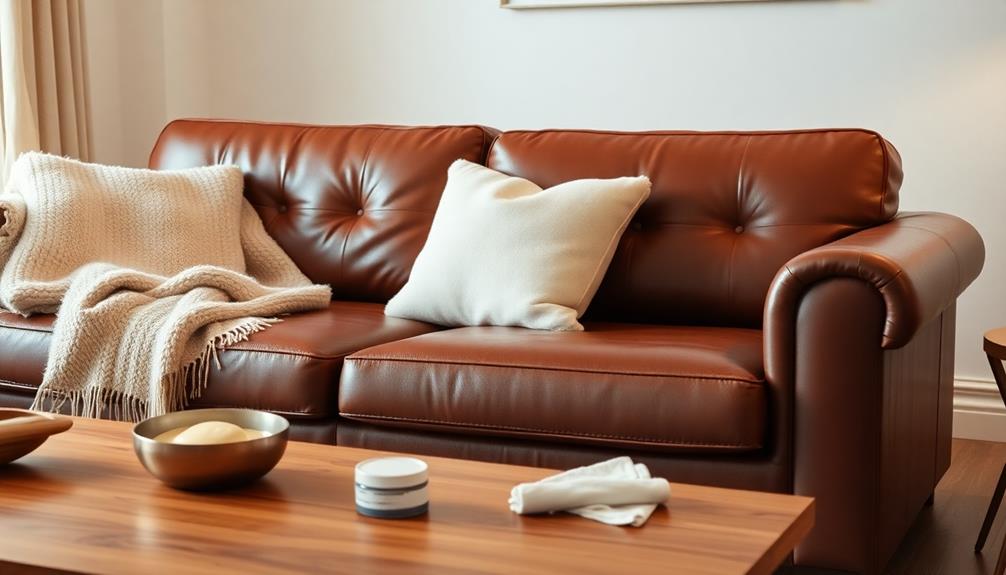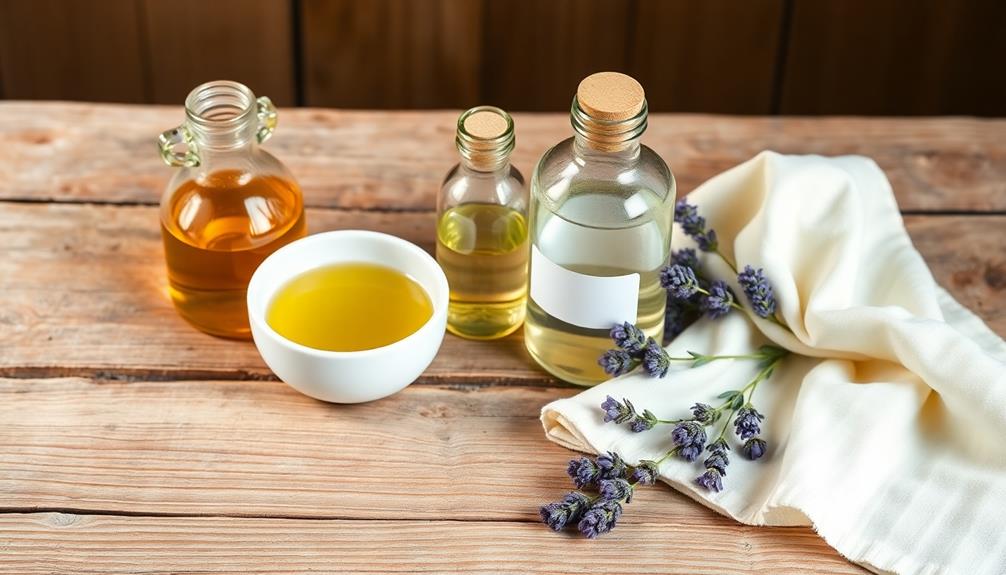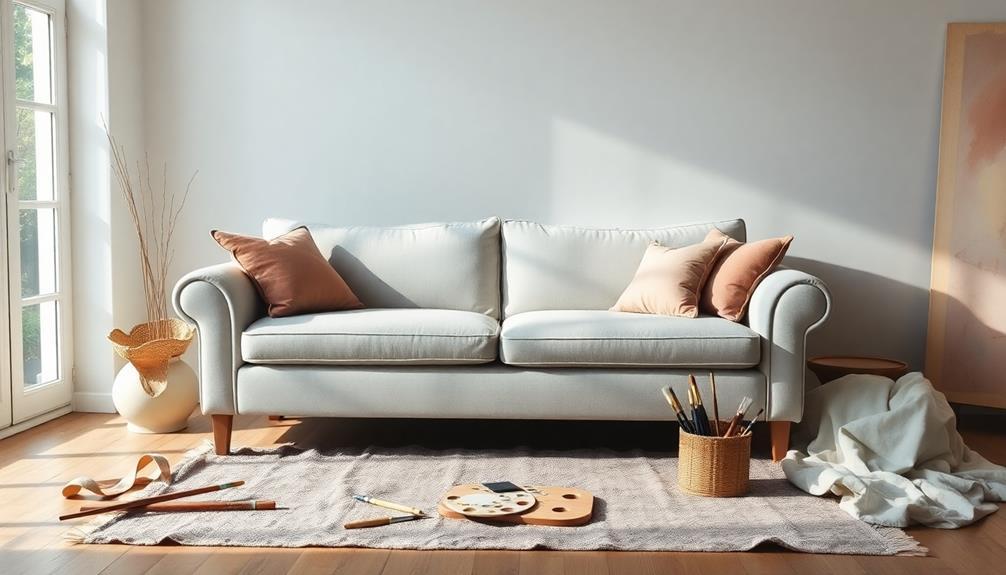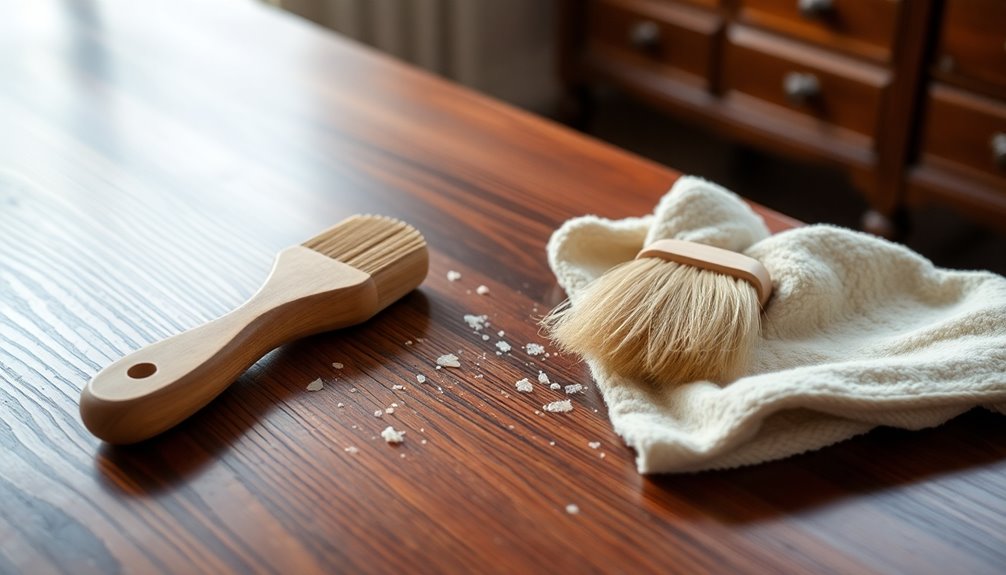To maintain the quality of your leather sofa, begin by regularly vacuuming it every few weeks to eliminate dirt and dust. Clean with a damp microfiber cloth and mild soap, ensuring not to over saturate the leather. Condition your sofa with a specialized leather conditioner at least twice yearly to preserve its moisture and flexibility. Keep in mind to avoid direct sunlight and heat sources that may cause harm. Swiftly blot spills with a clean cloth, refraining from using abrasive chemicals. By adhering to these guidelines, you can ensure your leather sofa remains in pristine condition for years to come, with more advanced care methods waiting to be discovered.
Key Takeaways
- Regularly dust and vacuum your leather sofa every 2-4 weeks to prevent dirt and oil buildup.
- Clean with a damp microfiber cloth and mild soap; avoid soaking the leather.
- Condition your leather sofa at least twice a year using a dedicated leather conditioner.
- Blot spills immediately with a clean, dry cloth; avoid using water or harsh chemicals.
- Position your sofa away from direct sunlight and heat sources to prevent damage.
Understanding Leather Types
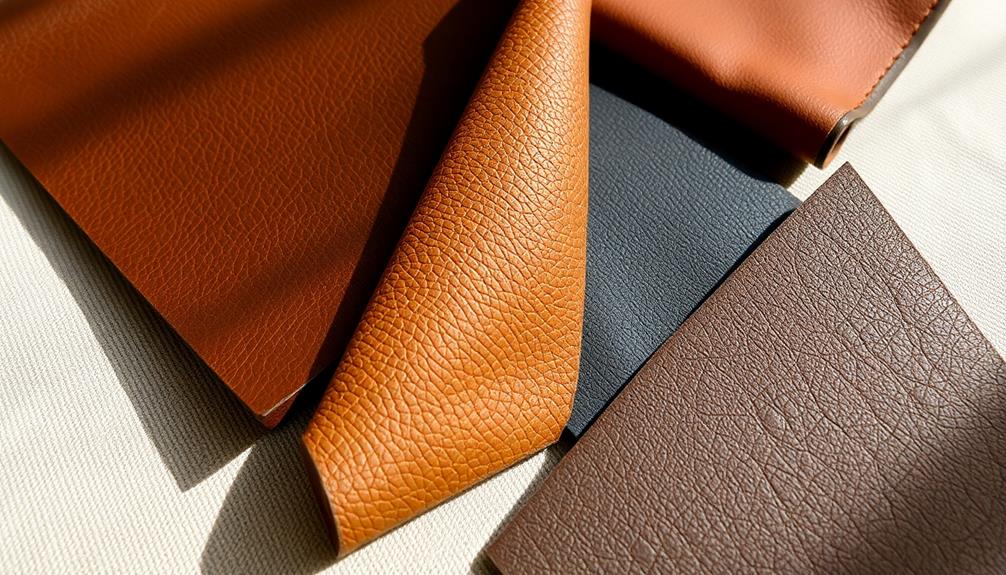
When it comes to caring for your leather sofa, understanding the different types of leather is crucial. You'll encounter real leather and faux leather, each requiring distinct care techniques.
Real leather, made from animal hides, can vary in quality and finish, influencing its durability and maintenance needs. Faux leather, on the other hand, is synthetic and generally more resistant to stains and moisture, making it easier to care for.
Additionally, using the right cleaning methods can help maintain air quality in your living space, as poor indoor air can affect your overall comfort. Regularly check and clean your air purifier filters to guarantee a healthy environment while enjoying your leather sofa, as air purifier maintenance dos can enhance your home experience.
Among real leather types, aniline-dyed leather retains its natural look but is more prone to staining, while pigmented leather features a protective coating that simplifies cleaning leather.
You'll want to use leather protection products to safeguard your investment. If your sofa has suede, which has a napped finish, it requires specialized care techniques, such as using suede brushes and erasers to tackle stains effectively. Additionally, regular conditioning is essential to maintain the softness and appearance of the material, ensuring it remains in pristine condition for years to come. When **buying the perfect sofa**, it’s important to consider the maintenance requirements of all materials used, so you can choose a piece that fits seamlessly into both your lifestyle and cleaning routine. Proper care will not only extend the life of your sofa but also preserve its beauty, making it a worthy addition to your home.
Understanding these characteristics helps you choose the right cleaning methods and leather protection strategies.
Always remember to condition your leather regularly to maintain its luster and prevent cracks, guaranteeing your sofa looks great for years to come.
Essential Cleaning Techniques
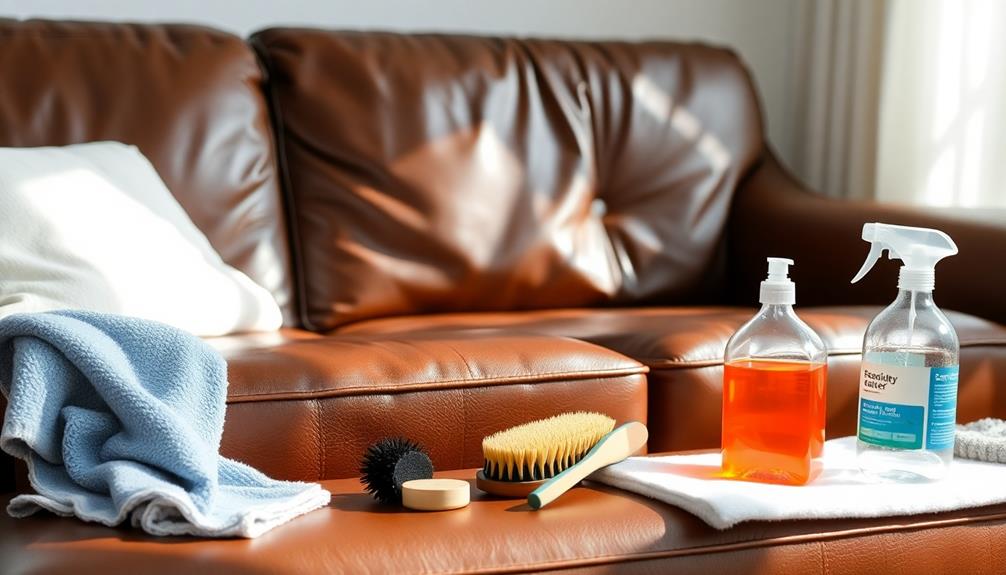
Caring for your leather sofa goes beyond understanding the types of leather; it also involves using the right cleaning techniques to keep it looking its best.
Start your maintenance routine by regularly vacuuming your leather furniture with a hose attachment. This removes dust and debris, preventing buildup that can cause discoloration and damage. Additionally, consider incorporating preventive maintenance plans into your home care routine to extend the life of your furniture.
When it's time to clean, use a microfiber cloth dampened with a solution of mild soap and water. Be careful not to soak the leather, as excess moisture can lead to damage. For any stains, opt for a specialized leather cleaner. Gently apply it with a soft cloth, following the manufacturer's instructions for the best results.
Always remember to perform a spot test on a hidden area before trying any new cleaning product. This way, you can check for adverse reactions or discoloration.
Avoid using household cleaners like dish soap or all-purpose cleaners, as they can strip the natural oils from the leather, resulting in brittleness and cracking.
Following these essential cleaning techniques will guarantee your leather sofa remains beautiful and well-maintained for years to come.
Conditioning Your Leather Sofa
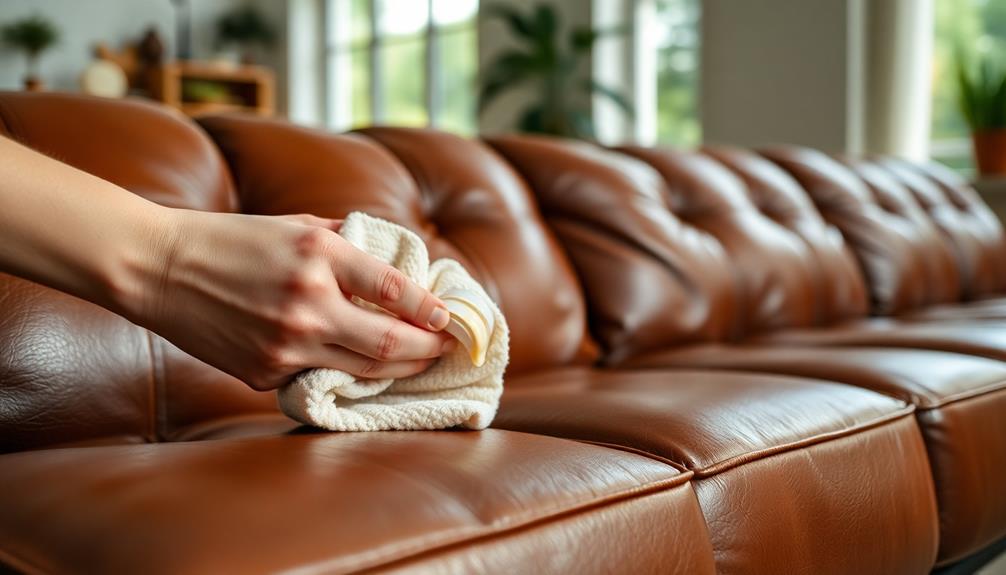
Conditioning your leather sofa is essential for keeping its appearance vibrant and preventing it from drying out or cracking. To maintain moisture levels and protect the leather's natural oils, you should condition your sofa at least twice a year.
Using a dedicated product like Leather Honey Leather Conditioner can effectively restore and nourish your leather, just as choosing the right vacuum can enhance your home cleaning routine by ensuring effective dust and allergen removal best vacuums for dust removal.
Here are some tips for conditioning your leather sofa:
- Always perform a spot test on a discreet area to check for any adverse reactions or discoloration.
- Use a microfiber cloth to apply the conditioner in circular motions, ensuring even coverage.
- After application, remove any excess product to avoid buildup.
- Regularly clean and condition your sofa to prevent dirt and oils from penetrating the material.
Common Maintenance Mistakes
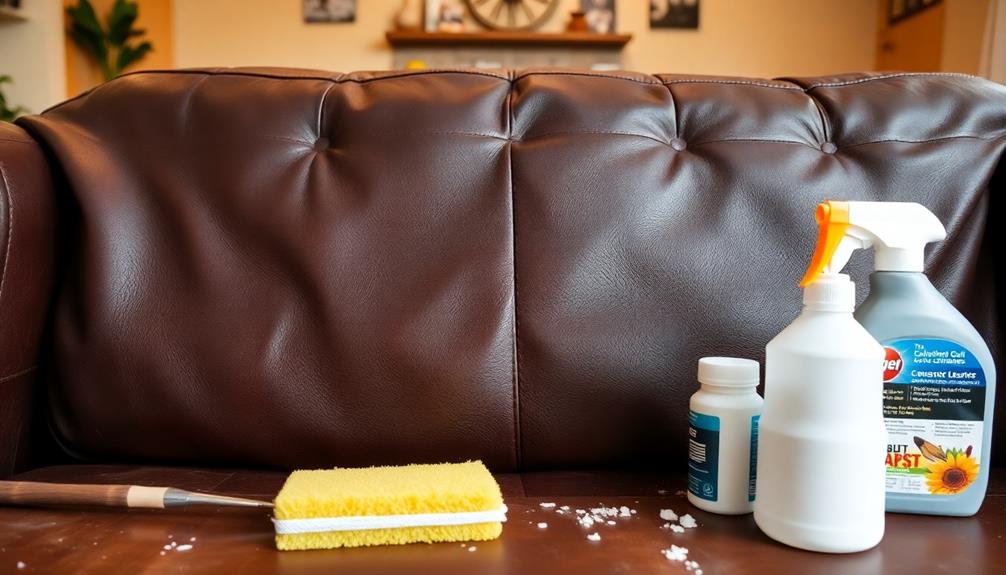
Your leather sofa deserves the best care, but common maintenance mistakes can undermine its longevity and beauty. One major mistake is using harsh chemicals or all-purpose cleaners. These can strip your leather of its natural oils, leading to brittleness and cracking over time. Instead, always use appropriate cleaning products specifically designed for leather furniture care.
It's also important to remember that similar to piercing care and hygiene, maintaining your leather requires gentle handling and the right products.
Another pitfall is neglecting regular maintenance. If you don't clean leather regularly, loose dirt and oils can build up, making future cleaning efforts more difficult. Remember to keep it away from excess moisture—over-saturating leather with cleaning solutions can lead to watermarks and even promote mold growth if not dried properly.
Also, don't ignore manufacturer care instructions. Failing to follow them can void warranties and result in improper treatment of your leather. Before applying any cleaning product, always test a small, inconspicuous area to avoid discoloration or damage.
Best Practices for Longevity
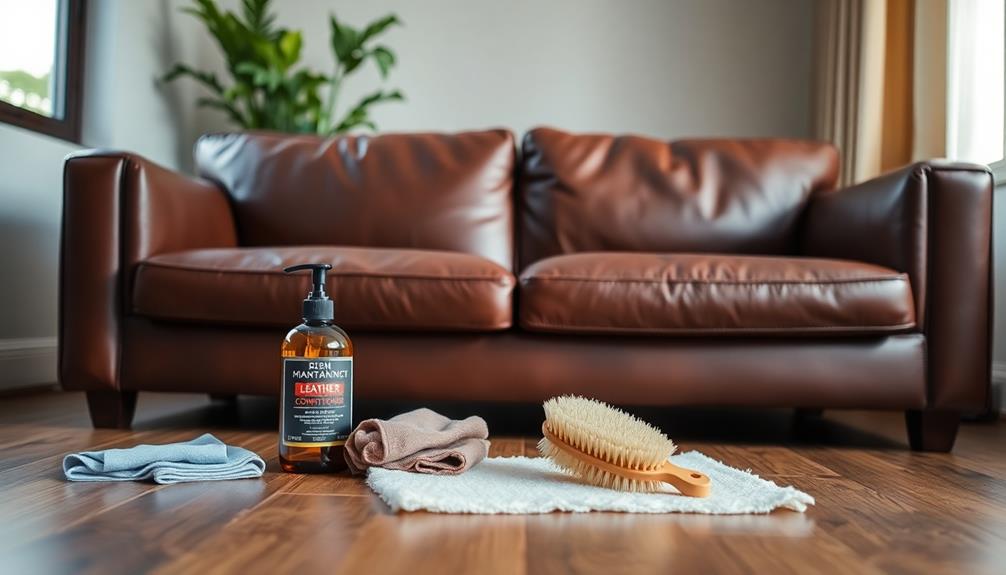
Maintaining the beauty and durability of a leather sofa involves adopting best practices that promote its longevity.
To keep your leather furniture looking its best, follow these essential tips:
- Dust and vacuum regularly: Every 2-4 weeks, clean your sofa to prevent dirt and oil buildup that can cause discoloration. Consider using a high suction power vacuum to efficiently remove debris without damaging the leather.
- Use a leather conditioner: Apply a high-quality conditioner at least twice a year to keep the leather moisturized and prevent cracking.
- Position wisely: Avoid direct sunlight and heat sources to minimize fading and drying out the leather.
- Utilize leather protectors: Apply a leather protector to create a barrier against stains and spills, enhancing durability.
When spills occur, quickly blot them with a clean, dry cloth.
Avoid using water or harsh chemicals, as they can damage the leather.
By following these best practices for leather cleaning and care, you'll guarantee that your leather furniture remains beautiful and functional for years to come.
Frequently Asked Questions
How Do I Take Care of My Leather Sofa?
To take care of your leather sofa, vacuum it regularly, clean with a mild soap solution, condition it twice a year, keep it away from sunlight, and quickly blot any spills to prevent stains. Additionally, avoid placing your sofa near heat sources, as this can dry out and damage the leather. If you notice it starting to sag or loosen over time, there are professional services available that can tighten leather on a sofa to restore its appearance. Finally, using a sofa cover when not in use can provide an extra layer of protection against dirt and wear.
Do Leather Couches Need Maintenance?
Yes, leather couches need maintenance. Did you know that regular care can extend their lifespan by up to 10 years? Vacuuming, conditioning, and avoiding extreme temperatures are essential to keep your leather looking great.
What Is the Best Thing to Condition a Leather Couch With?
The best thing to condition your leather couch with is a dedicated leather conditioner, like Leather Honey. It restores moisture, prevents cracking, and maintains suppleness. Remember to test it on a small area first!
What Can Ruin a Leather Couch?
Did you know that 80% of leather damage comes from improper care? Direct sunlight, moisture, and harsh chemicals can ruin your leather couch. Avoid scratches from pets and never place hot items directly on it.
Conclusion
In the end, caring for your leather sofa isn't just about preservation; it's about embracing the stories it'll gather over time. Each scratch and mark tells a tale, a reflection of your life's moments. If you neglect its care, though, those stories could fade too soon. So, as you nurture your sofa, consider this: what legacy do you want to leave behind? With the right attention, your leather piece can become a cherished heirloom, waiting to share its history.
